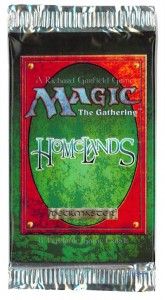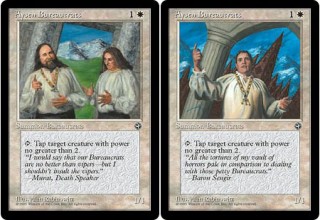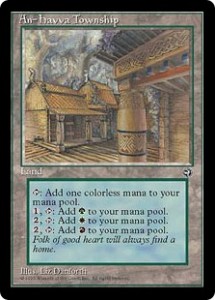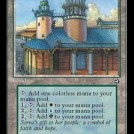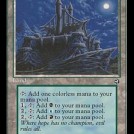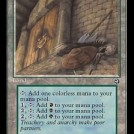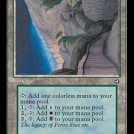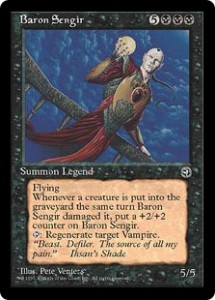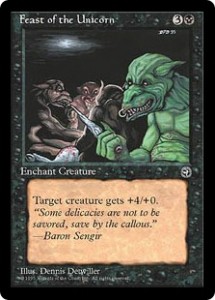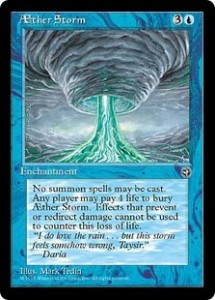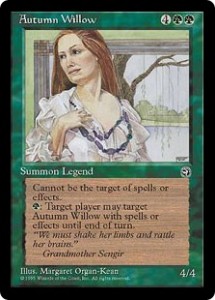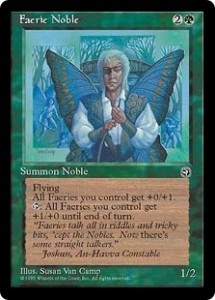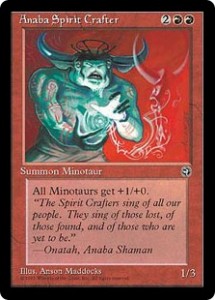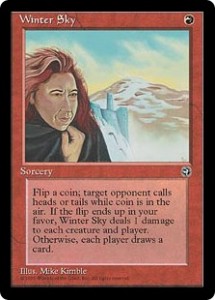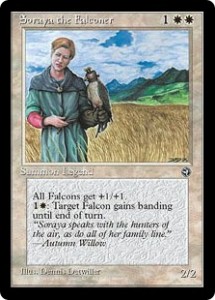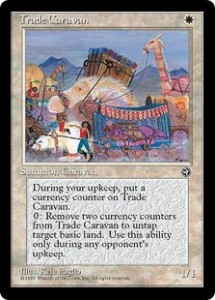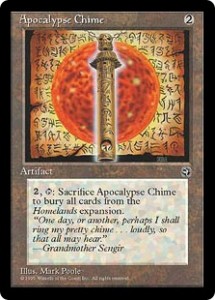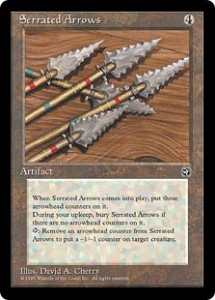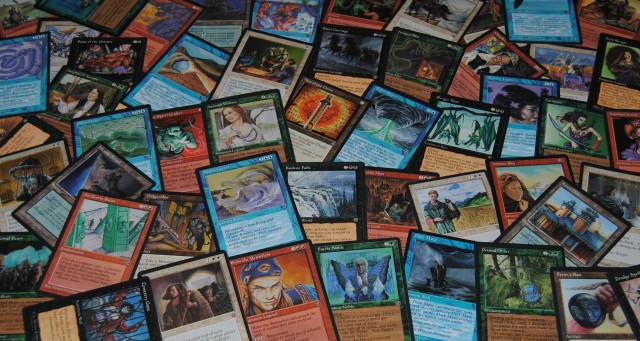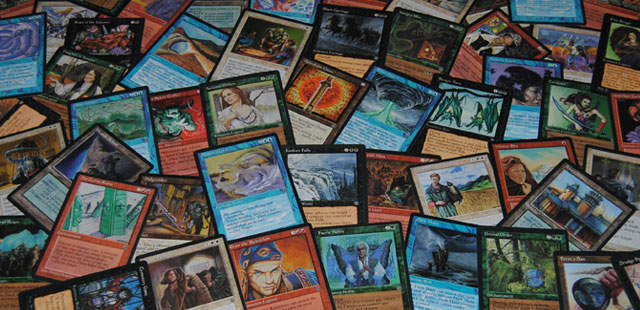
An Introduction to Homelands
Released in October of 1995, Homelands, Magic: The Gathering’s seventh expansion, was a small expansion set that numbered 140 total cards. The color breakdown was even across the board with 25 Black cards, 25 Blue cards, 25 Green cards, 25 Red cards, 25 White cards, 10 Artifacts cards, and 5 Lands.
The set contained 69 Commons and 71 Uncommons; although the Uncommons were broken down having the 26 U3’s act as the true Uncommons and the 45 U1’s act as the sets Rares or Rare-equivalent. Homelands was released in 8 card booster packs, less than the 12 card packs of Chronicles and Alliances and even more less than the standard 15 card packs.
The set added to the Sengir, Serra and Clockwork families, in addition to adding new prefixes such as Anaba, Aysen and An-havva. The set also added some new viable tribes, Faeries, Minotaurs and Falcons (which are now classified as Birds).
Homelands also featured 14 Legendary creatures, the most Legendary creatures in a set since Legends, and one of the last true expansion sets to include that many, as well.
Homelands also had artwork variations similar to Fallen Empires. 25 cards had two artwork variations, five cards in each of the five colors to be exact. Outside of basic Lands, this was one of the last sets to maintain the same card with two variations of artwork, the next set Alliances would be the last.
It’s one of the few things in the game that I wish hadn’t changed. Having a playset of cards in play, all with different artwork was a beautiful part of the game, that has since been lost to history and the “Old School” sets.
The Lands of Homelands: The Pay-Per-Color Lands
The Lands of Homelands were pay-per-color Lands. Pumping Mana into Land is nothing new. Safe Haven, the Storage Lands of Fallen Empires and Mishra’s Factory all require a cost, but these were different. These were Lands that produced colorless Mana, and for a cost of one or two colorless Mana could give you any of three colors of Mana.
There were five of them; An-havva Township, Aysen Abbey, Castle Sengir, Koskun Keep and Wizards’ School and each represented the color Mana you could get for the cost of one colorless Mana and had an additional two options for the two colorless Mana Cost.
They weren’t used often, as they were much slower than the pain lands of Ice Age and the dual lands of Revised, but they still had some uses. You could, for example, throw an An-havva Township in your straight green deck to allow you to add a White or Red card to your deck, without needing to add a Mountains or a Plains. This pumping Mana into Land concept is now much more common with newer Lands that have been printed in other sets, but the blueprint of the mechanic starts here, with these five lands.
The Color Black in Homelands: The Family Sengir and More
The first family of Black, Sengir, put it’s stake into the ground with Homelands. Sengir Vampire was joined by Baron Sengir, Grandmother Sengir, Irini Sengir, Sengir Autocrat, Sengir Bats and Veldrane of Sengir.
The standouts of the family from this set are Baron, Irini, the Autocrat and the Bats. Baron Sengir is a Legend that regenerates other Vampires, Irini Sengir makes White and Green enchantments cost and additional two Mana to cast, the Sengir Autocrat comes into play with three 0/1 Serf tokens and the Sengir Bats is a smaller, cheaper Sengir Vampire.
There were other big creatures added to the Black arsenal as well, Black Carriage and Ihsan’s Shade. Additionally, there were plenty of enchantments and instants that lowered creatures power and/or toughness.
However, three Black Homelands enchantments stand out about the rest, Drudge Spell, Feast of the Unicorn and Koskun Falls.
Drudge Spell allowed you to create Drudge Skeleton-like creature tokens, Feast of the Unicorn gave the enchanted creature +4/+0 and Koskun Falls was the original Propoganda, although you had to tap and untapped creature as an upkeep cost.
Amazingly, enough although ante cards were being phased out, there was one printed in Homelands, Timmerian Fiends. I’m not sure why, it’s not really special as ante cards go, it allows you to destroy an artifact or opponent may ante another card to counter this ability. It’s not bad, but nothing to really write home about, either. So I’m really not sure why they printed it, as with the advent of all the power cards of Ice Age, no one was really playing for ante anymore.
The Color Blue in Homelands: Control, Creature Control and Defense
There was a storm brewing in Homelands, AEther Storm. It was the ultimate in anti-creature enchantments. “No summon spells may be cast. Any player may pay 4 life to bury AEther Storm. Effects that prevent or redirect damage cannot be used to counter this loss of life.” It was a powerful card, even more so in melee games, but it also made you an instant target, once it was gone, unless you could get another one out.
Baki’s Curse was the anti-Rabid Wombat deck card, dealing two damage to each creature for each enchantment on that creature, Chain Stasis allowed you to tap or untap anything, but gave that target’s controller the ability to do so as well. Play it early on and it could be a one and done, but played deep into a game, with the Mana flowing, it could take a while to sort out.
Dark Maze was a 4/5 wall, that could attack, but would be destroyed at end of turn, Jinx allowed you to change target land to the basic land of your choice with a cantrip, Marjhan was a huge Blue 8/8 serpent, with a huge uptap cost and Wall of Kelp was a 0/3 that with two Blue Mana, allowed you to pump 0/1 Kelp Wall tokens out into play.
Memory Lapse was a Counterspell that put the spell back on top of opponent’s library, so if you had a Millstone running, it wasn’t just a lapse in memory, it was gone forever. Merchant Scroll allowed you to search your library for a Blue instant or interrupt and Labyrinth Minotaur changed the way we thought about Minotaurs, being that it was a Blue Minotaur.
Mystic Decree was the power card for Blue in Homelands, because it was immediately paired with Island Sanctuary. Mystic Decree was an enchant world, “All creatures lose flying and islandwalk” and when paired with the Island Sanctuary enchantment of only creatures with flying or islandwalk can attack you, it was quite the combo to build a deck around. I have yet to complete building my Island Sanctuary / Mystic Decree deck. I have a playset of each, but aside from Counterspells, Disenchants and Prodigal Sorcerers, I’m not sure which direction to go.
The Color Green in Homelands: Enter the Faeries and More Big Creatures
Green had a few good spells, Primal Order and Carapace, but as good as those may be it is the creatures of Green that make a huge statement in Homelands.
Starting with those spells, because they are not to be overlooked, Primal Order, in it’s day, wasn’t nearly as powerful as it would be now with all of the non basic lands that have been put into print. Carapace is just a creature enchant that gives target creature +0/+2, but the enchantment can be sacrificed to regenerated the enchanted creature and it only costs one Green Mana, which is very useful. Now onto the big and not-so-big Green creatures.
Autumn Willow was one of the standout creatures, because you could turn off “Cannot be the target of spells or effects” and pump her up should you need to. An-havva Constable was a great addition to an Elf deck, because it was a 2/1+*, where * was equal to the number of Green creatures in play, making it a very big wall in most Elf decks.
Faerie Noble and Willow Priestess were big for Willow Faerie, within the set and Scryb Sprites from Fourth and Revised Editions. Faerie Noble gave all Faeries you control +0/+1 and you could tap the Noble to give all Faeries you control +1/+0 until end of turn. The great thing about this was that it was all Faeries YOU control and not just all Faeries.
Willow Priestess was a Faerie in her own right, but allowed you to put a Faerie from you hand into play, without paying its casting cost and could give target Green creature protection from Black. The Priestess and the Noble made the Faeries a tribe to be reckoned with.
For me though, the best creature from Homelands in Green was hungry Mist. Hungry Mist was a 6/2, with an upkeep for two Green Mana, but it only cost two Colorless and two Green Mana to cast. With an Elf in play, that’s easily a turn three 6/2 and you only have to hit your opponent once, in order for them to target it and save you on the upkeep cost.
The Color Red in Homelands: Welcome to the World of Dwarves and Minotaurs
Move over Goblins and Orcs, with the printing of Homelands, Minotaurs and Dwarves got to have their moment in the sun.
The Anaba Minotaurs can pump each other up, deal damage to target creature or player and some have first strike, but it was the Didgeridoo that made it all possible and viable as a deck concept. The Minotaurs of Homelands were not cheap, but with a Didgeridoo out, they could be. Didgeridoo was an artifact in Homelands that cost one colorless Mana, “Tap three colorless Mana: Take a Minotaur from your hand and put it directly into play as though it were just summoned.” This made the Minotaur deck work.
The Dwarves were still cheap, but now they had more variety to their ranks, with the additions of Dwarven Pony, Dwarven Sea Clan and Dwarven Trader. Heart Wolf also aided a dwarf with it’s ability to give target dwarf first strike and +2/+0 until end of turn.
But hold on, don’t go tribal with your deck yet, because An-Zerrin Ruins was the ultimate anti-tribal deck card. It was an enchantment which stated, “Choose a creature type. Creatures of that type to do not untap during their controller’s untap phase.”
Minotaurs being medium and Dwarves being small, did not mean Red didn’t have some big creature additions. Chandler was a 3/3, but he could destroy target artifact creature and his buddy Joven was a 3/3 that could destroy target non-creature artifact. Eron the Relentless was a 5/2 that didn’t have summoning sickness and could be regenerated with three Red Mana.
Red wasn’t all about creatures though. Ironclaw Curse and Retribution were great spells for targeting your opponents’ creatures, Orcish Mine was a great way to slowly destroy a land and do damage to your opponent, but the height of Red fun in Homelands was Winter Sky.
Winter Sky said, “Flip a coin, target opponent calls heads or tails while coin is in the air. If the flip ends up in your favor, Winter Sky deals 1 damage to each creature and player. Otherwise, each player draws a card.” As a sorcery for one Red Mana, this is as close to a win win situation as you can get, because Red never had much card draw ability.
The Color White in Homelands: The Falcons beget Birds, Rise of Serra and other useful Spells
Homelands’ White received a new tribe, a few useful creatures and some very powerful spells. The new tribe, of course, was Falcons. Granted a small tribe at the time, Falcons are now no longer. They are now all classified as Summon Birds, but you can trace the tribe of birds back to one powerful Legend, Soraya the Falconer, which originally gave all Falcons +1/+1, but now the errata says it gives all Birds +1/+1.
Soraya also can give target Bird banding until end of turn, but banding isn’t quite what it used to be. In Homelands, the only other Falcon you could boost, at that time was Mesa Falcons, but those days are gone and now you can boost your Bird Soldiers and many more.
Serra Angel had a few tools and relatives added to White in Homelands, as well. On the creature front Serra Inquisitors and Serra Paladin were useful enough, but for sheer power, Serra Aviary, which gives “All creatures with flying +1/+1,” and Serra Bestiary, which is like a Pacifism, but with and upkeep, were much more valuable to decks, at the time.
Death Speakers is a great anti-Black card as a 1/1, one White Mana costing, protection from black weenie, hazduhr the Abbot is a Legend, which can allows you to avoid that Lighning Bolt on small weenies, Rashka the Slayer is a 3/3 that can block flying and gets a boost if assigned to block any Black creatures, but again, White isn’t all creatures, along with the aforementioned Aviary and Bestiary are Leeches, Prophecy and Truce.
Leeches, at that time, was the only way to remove poison counters, albeit at a cost of one damage per counter. Prophecy, was just a cantrip with a chance to gain a single life and Truce allowed, “Each player mad draw up to two cards. For each card less than two any player draws, that player gains 2 life.”
Lastly, there was one often overlooked, but highly useful White weenie in Homelands; Trade Caravan. It cost one White Mana and was a 1/1, with a great ability. “During your upkeep, put a currency counter on Trade Caravan. 0: Remove two currency counters from Trade Caravan to untap target basic land. Use this ability only during any opponent’s upkeep.”
The drawback of when it was used, wasn’t really a drawback, as Trade Caravan was used in Blue/White decks, to untap lands for countering potential creatures, enchantments or other harmful spells. This was Trade Caravan’s most used purpose and it was very good at it’s job.
The Artifacts of Homelands: Something Old and Something New
Although there were only ten Artifacts in Homelands, that doesn’t mean they didn’t have a lasting impression on the game. Apocalypse Chime was a throwback, three Clockwork creatures joined the Avian and Beast, Didgeridoo was helpful for Minotaurs, Roterothopter was an Ornithopter with some power and Serrated Arrows was the highlight of them all.
Apocalypse Chime was a throwback to Antiquities and Arabian Nights. Apocalypse Chime stated, “two Colorless Mana TAP: Sacrifice Apocalypse Chime to bury all cards from the Homelands expansion.” This is a throwback, because it wasn’t since City in a Bottle in Arabian Nights and Golgothian Sylex in Antiquities that a card effected all of the cards from a particular set.
Clockwork Gnomes, Clockwork Steed and Clockwork Swarm added to the already established Clockwork Avian and Clockwork Beast to make more Artifact creatures with power and/or toughness tokens more well known, these five have since been joined by five more Clockwork creatures.
Mentioned earlier, in the Red section, was Didgeridoo an Artifact that allowed you to easily drop the Minotaurs from your hand into play, but it was Serrated Arrows that was the power Artifact of Homelands.
Serrated Arrows was a common in Homelands. A mere common, which would explain its widespread use, except that, I believe, it would have been used anyway. “When Serrated Arrows comes into play, put three arrowhead counters on it. During your upkeep, bury Serrated Arrows if there are no arrowhead counters on it. TAP, Remove an arrowhead counter from Serrated Arrows to put a -1/-1 counter on target creature.”
It uses were many but the two main uses were, destroying pesky weenie creatures and lowering the power and toughness of that Shivan Dragon you just cloned with your Vesuvan Doppleganger, so your copy was bigger. Serrated Arrows was later printed as a Timeshifted card, in Time Spiral.
In Conclusion Homelands
Homelands was very much its very own stand alone expansion, although it was considered part of the Ice Age Block.
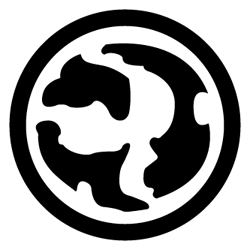
Homelands Expansion Symbol
It was an expansion set similar to the original expansions, both in size and concept. It had elements of Fallen Empires with the artwork variations. It had an Artifact that effected all cards within the Homelands expansion set and it included a larger than normal number of Legends for a set of its size.
You could say Homelands broke the mold, as no other set since has been built as close to the original expansions of Antiquities, Arabian Nights, Legends and The Dark, than Homelands was.
Homelands started the move away from Banding and the move towards more activations and abilities within the upkeep and it added more cantrip cards to Magic: The Gathering’s library, which was very much a sign of things to come.
Homelands was fun to play and had some great cards, although most have been lost in the “New School” of Magic play, the “Old School” player will still have reverence for the set, as I do.
